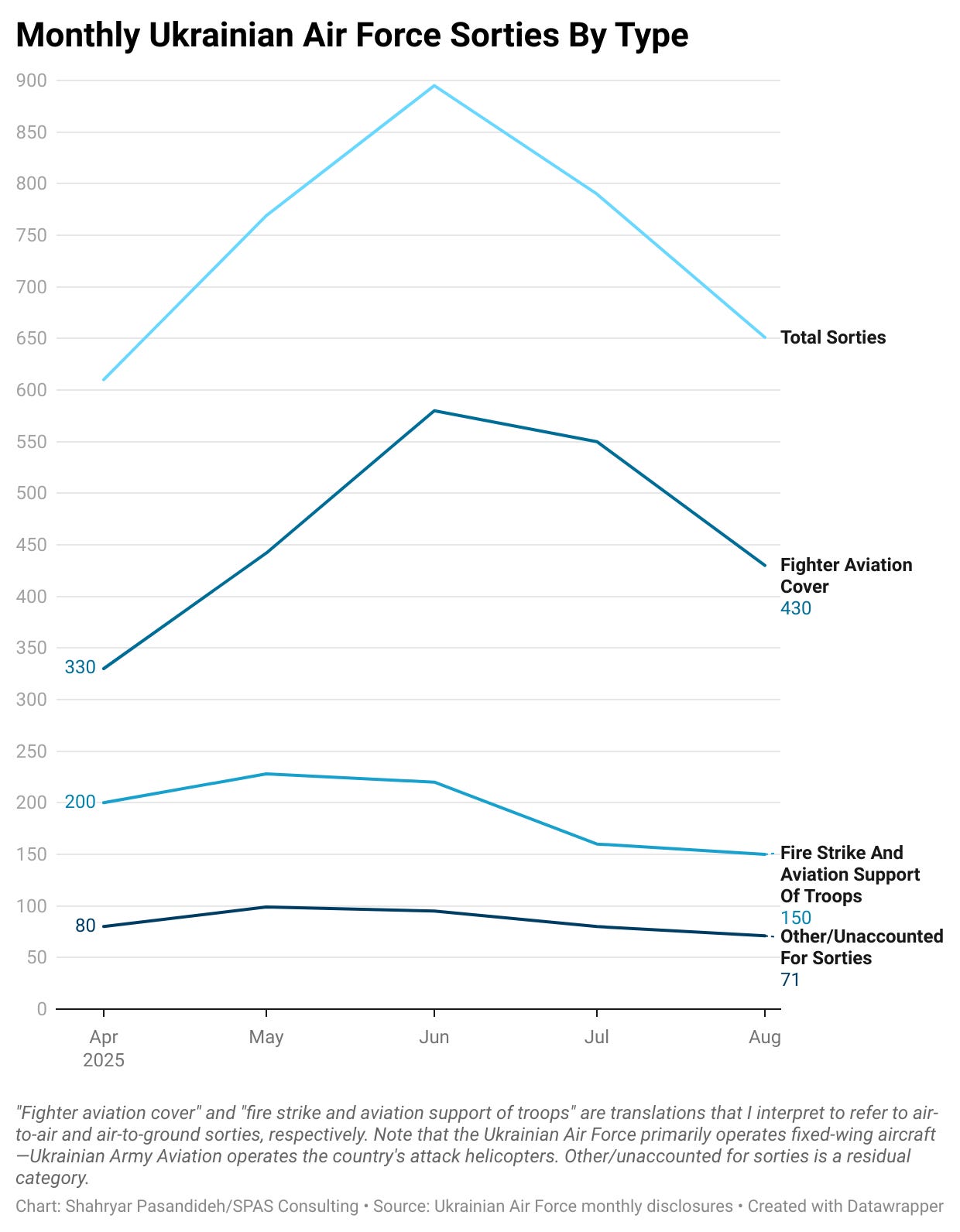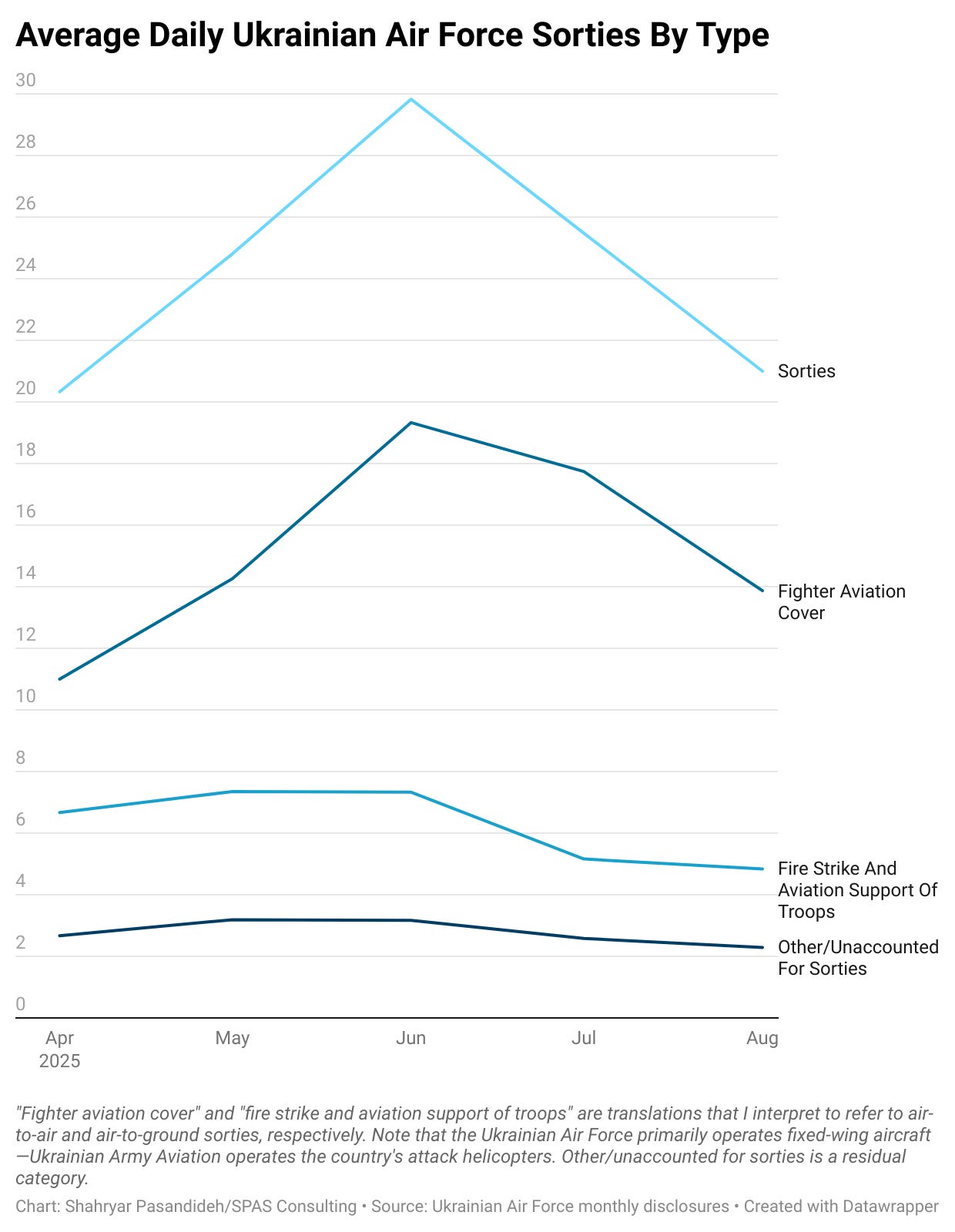Note: The following text was originally posted on my X/Twitter account.
While the regular stream of videos showing Ukrainian Air Force fighter aircraft—Soviet-built Su-27 and MiG-29 fighter aircraft, Su-24 strike aircraft, and Su-25 attack aircraft, as well as American-origin F-16 fighter aircraft and French-built Mirage 2000 fighter aircraft—undertaking air-to-ground sorties when equipped with foreign-supplied guided bombs, land-attack cruise missiles, and other guided air-to-ground munitions highlights the non-trivial growth of Ukrainian military capabilities, it is important for observers to develop an accurate understanding of scale and regularity of such air-to-ground sorties. Fortunately, the Ukrainian Air Force—which operates the country's fixed-wing crewed combat aircraft—has been making monthly disclosures of the number of sorties it has generated.
This allows observers to not only assess the Ukrainian Air Force's monthly sorties and sorties by type but also discern the average daily number of sorties and sorties by type.
If we accept the data in the Ukrainian Air Force's monthly disclosures at face value, most of the sorties that the Ukrainian Air Force has undertaken since April 2025 were—unsurprisingly—air-to-air combat sorties. This presumably includes standing combat air patrols in sectors located close to the frontlines—which is to say sorties for which the intended targets are primarily Russian fixed-wing and rotary-wing crewed combat aircraft—quick reaction alert sorties across Ukrainian airspace, and rear area air-to-air sorties that are undertaken with the primary objective of intercepting inbound Russian cruise missiles and/or propeller-driven strike drones (i.e., the Shahed-136/Geran-2/Garpiya). The other/unaccounted for category is a residual that may or may not encompass training and testing/research and development sorties. Note that the Ukrainian Air Force faces strong incentives to allocate—convert—as many training sorties into combat sorties as possible. This is, however, less practical when sorties are flown by less experienced aircrew. It is also important to note that the Ukrainian Air Force is known to use its turbojet-powered L-39 trainer aircraft to intercept Russian propeller-driven strike drones in rear areas/sectors situated far from the frontlines.
While the aggregate monthly figures may appear impressive in absolute terms, given that there is no baseline for comparison, the imputed daily average figures are decidedly unimpressive, irrespective of the relatively small size of the Ukrainian Air Force's combat aircraft fleet and the low serviceability rates that it is likely to encounter following over three and a half years of sustained combat operations. The Ukrainian Air Force's monthly disclosures indicate that it has generated an average of just 20-30 sorties per day from April 2025 through August 2025. The "fire strike and aviation support of troops" sorties—air-to-ground sorties—that receive so much attention appear to be limited to a daily average of 4-6 sorties from April 2025 through August 2025. It bears emphasis that some portion of the presumably air-to-air "fighter aviation cover" sorties may entail the carriage and release of some number of air-to-ground munitions.
All things considered, these figures—which are directly sourced from the Ukrainian Air Force's monthly disclosures—indicate an air force that is predominantly tasked with generating air-to-air sorties. Observers viewing the regular stream of images and videos of Ukrainian Air Force crewed fixed-wing combat aircraft equipped with guided air-to-ground munitions and videos of the detonation of said munitions should, therefore, be mindful of how few sorties—especially air-to-ground sorties— the Ukrainian Air Force appears to be generating on a given day. As with so many aspects of the Russia-Ukraine War, there seems to be less here than meets the eye.



